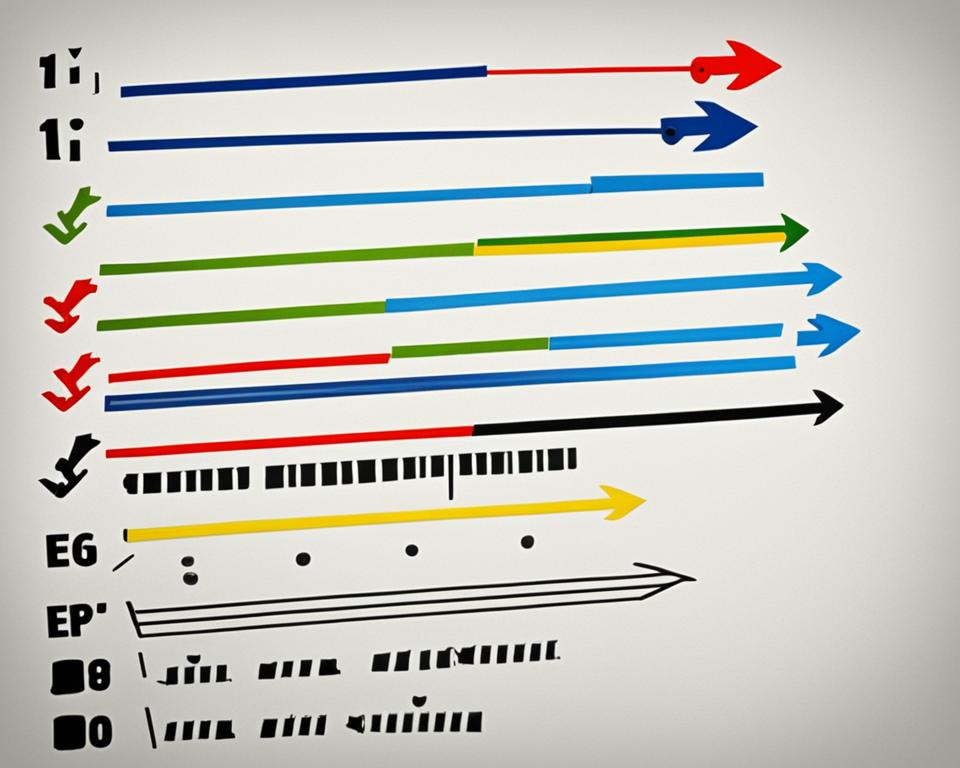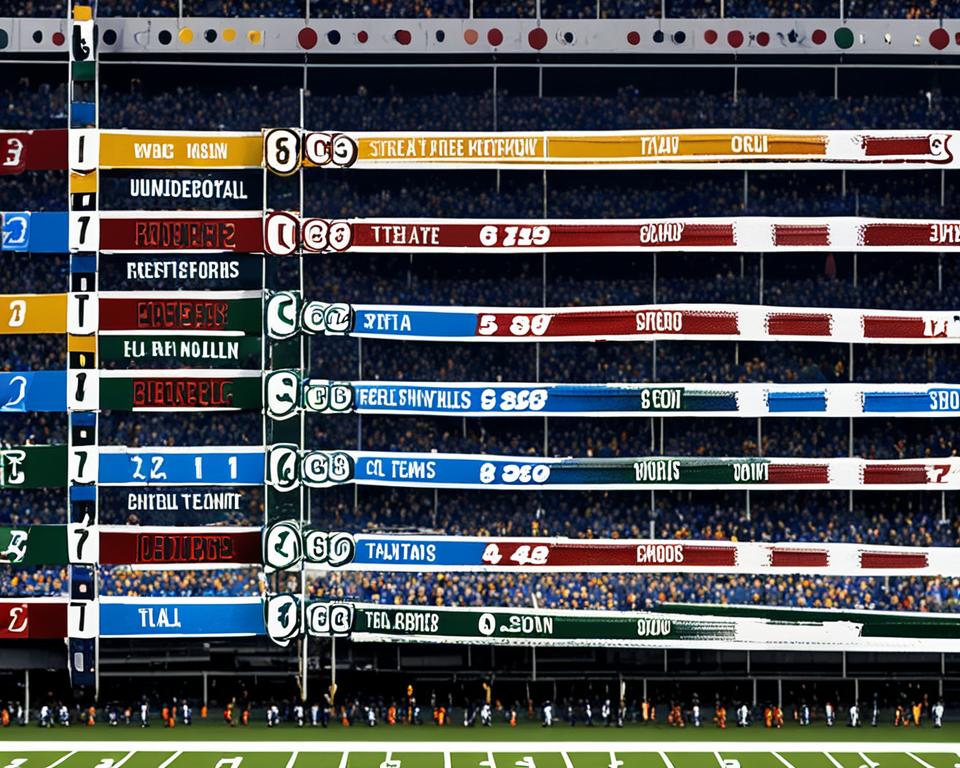Betting on sports is a popular hobby, especially in the United States where the NFL draws the majority of bets. However, for beginners, sports betting can be intimidating and confusing. In this article, we will explain the concept of point spreads in sports betting, including how they work, why they have a .5 at the end, and how to read and interpret point spread odds. By the end of this article, you will have a clear understanding of point spreads and be able to make more informed wagers in sports betting.
Key Takeaways:
- Point spreads are the expected final score difference between two teams in a game.
- The negative number is assigned to the favored team, while the positive number goes to the underdog.
- The .5 at the end of point spreads helps avoid pushes or ties.
- The (-110) next to the point spread represents the betting juice or vigorish.
- An over/under is a bet on the combined points scored by both teams in a game.
What is a Point Spread?
A point spread is a fundamental concept in sports betting that predicts the expected score difference between two teams in a game. It is expressed as both a negative and positive number, indicating the favored team and the underdog, respectively. The actual number itself represents the projected margin of victory for the favored team, regardless of the sign.
For example, let’s say Team A is a 3-point favorite over Team B. This means that for a bet on Team A to be successful, they must win by more than 3 points. If the game ends with a final margin of exactly 3 points, it is considered a tie or a push, resulting in a refund of the bet.
The point spread adds an element of excitement and challenge to sports betting, as it levels the playing field by adjusting the perceived advantage between the teams. It allows bettors to not only predict the outcome of the game but also the margin by which the favored team will win.
How Point Spreads Work
When a point spread is determined, the favored team is assigned the corresponding negative number, while the underdog is assigned the positive number. This negative or positive number represents the expected number of points that the favored team is favored to win by.
For example:
Team A: -6
Team B: +6
In this scenario, the sportsbook predicts that Team A will win by 6 points. To win a bet on Team A, they must win by more than 6 points. On the other hand, if you bet on Team B, they can either win the game outright or lose by less than 6 points for your bet to be successful.
The Importance of Half-Point Spreads
You may have noticed that point spreads often include a decimal number, such as 3.5 or 6.5. These half-point spreads are used to prevent ties or pushes, ensuring that there is always a clear winner and loser in the bet.
For example, if the point spread is 3.5 and the favored team wins by exactly 3 points, it results in a tie. However, with the half-point spread, there can never be a tie, as it ensures that the favored team must win by more than the specified point spread to be considered a winning bet.
Why Do Point Spreads Have a .5 at the End?
In the world of sports betting, point spreads are a fundamental aspect that determines the outcome of wagers. You may have noticed that point spreads often include a .5 at the end, and you might be wondering why. The answer lies in the aim to avoid ties or pushes.
A tie or push in sports betting occurs when the final margin of victory matches the point spread. In this case, neither the bettor nor the sportsbook wins or loses the wager. To ensure that there is always a definitive outcome, point spreads are adjusted with a .5 added.
For instance, let’s say the point spread is set at 3.5. If you wager on the favorite, they must win by more than 3.5 points (meaning winning by 4 or more points) for the bet to be successful. By including the .5, the sportsbook eliminates the possibility of a tie, guaranteeing that there will always be a winner and a loser in the bet.
Adding the half point to the point spread introduces an extra layer of excitement and tension to the betting experience. It forces bettors to consider not only the outcome of the game but also the margin of victory required to cover the spread.
The Importance of Half Points in Point Spreads
“By incorporating half points in point spreads, sportsbooks ensure there’s no possibility of a tie, adding thrill and uncertainty to the betting experience.”
While a .5 point may seem insignificant, it plays a crucial role in determining the outcome of a bet. The addition of the half point ensures that bettors’ predictions are either validated or disproven, leaving no room for ambiguity.
Next time you’re considering placing a sports bet, pay close attention to those point spreads with a .5 at the end. They are designed to keep you engaged, as there will always be a clear winner or loser, adding an extra layer of excitement to your betting experience.
Key Takeaways
- Point spreads have a .5 at the end to avoid ties or pushes in sports betting.
- By including the half point, there will always be a definitive outcome.
- The .5 ensures that either the bettor or the sportsbook will win or lose the wager.
- Adding the half point adds excitement and uncertainty to the betting experience.
Understanding the Numbers (-110) Next to the Point Spread
The (-110) next to the point spread is the vigorish, also known as the betting juice. It represents the amount of money the bettor needs to risk to win $100. A negative number (-110) means the bettor needs to risk $110 to win $100, while a positive number (+110) means the bettor can win $110 with a $100 wager. The vigorish is how sportsbooks make their profit, as it ensures that there is always a slight advantage in favor of the house. The (-110) is the standard vigorish for most point spread bets.
| Vigorish | Bettor’s Risk | Winnings on $100 Bet |
|---|---|---|
| -110 | Risk $110 | Win $100 |
| +110 | Risk $100 | Win $110 |
What is an Over/Under?
An over/under, also known as the total, is a popular type of bet in sports betting. It involves wagering on the combined points that both teams will score in a game. The sportsbook sets a predicted total, and bettors can choose to bet whether the final score will be over or under that total. The over/under bet is not limited to just the final score of the game; it can also be applied to individual quarters, halves, or any other specific time frame.
For example, let’s say there is an NBA game between the Los Angeles Lakers and the Golden State Warriors. The sportsbook sets the over/under line at 220.5 points. If a bettor believes that the final score will be high-scoring and exceed 220.5 points, they would wager on the over. Alternatively, if they think the final score will be low-scoring and stay below 220.5 points, they would bet on the under.
Over bets win if the combined score of both teams exceeds the total set by the sportsbook. Under bets win if the combined score is below the total. In case the final score exactly matches the total, it is called a push, and the bettors get their money back.
Example:
The over/under line for a football game between the New England Patriots and the Kansas City Chiefs is set at 45.5 points. A bettor who believes it will be a high-scoring game with a final score of 28-24 for the Chiefs would bet on the over. If the final score is indeed 28-24, the total score will be 52, which is over the 45.5-point line. Therefore, the over bet would be a winner.
Why Are Over/Unders Popular?
Over/under bets are popular because they add excitement to games that might not have a clear favorite or underdog. They offer a different dimension of betting by focusing on the scoring output of both teams rather than the outcome of the game. Over/under bets are prevalent in many sports, including basketball, football, soccer, and hockey.
Additionally, over/unders can be a great option for bettors who might not have a strong opinion on which team will win but have a better understanding of the potential score range. It allows bettors to root for both teams to contribute to the total score, regardless of the game’s outcome.

Explaining Moneyline Betting
In sports betting, moneyline betting is a straightforward and popular form of wagering on which team will win a game, regardless of the point spread. Unlike point spreads, which take into account the margin of victory, moneyline bets focus solely on the outcome of the game.
The odds for moneyline betting are expressed as positive or negative numbers, representing the favorite and the underdog teams. A negative number indicates the favorite, while a positive number represents the underdog.
When betting on the favorite team with a negative number, it indicates how much you would need to bet in order to win $100. On the other hand, when betting on the underdog team with a positive number, it signifies how much you would win with a $100 bet.
An Example:
Let’s consider a hypothetical match between the Kansas City Chiefs and the Cincinnati Bengals. The moneyline odds for this game are as follows:
| Team | Moneyline Odds |
|---|---|
| Kansas City Chiefs | -350 |
| Cincinnati Bengals | +275 |
If you bet $350 on the Kansas City Chiefs (-350), a successful wager would yield a $100 profit. On the other hand, if you bet $100 on the Cincinnati Bengals (+275), a successful bet would result in a $275 profit.
Moneyline betting provides a clear and simple way to bet on the outcome of a game, offering different odds for favorites and underdogs. It is particularly popular in sports like boxing, MMA, and tennis, where there are no point spreads to consider.
While moneyline betting eliminates the complexity of point spreads, it’s essential to understand the odds and the potential payout before placing a bet. By familiarizing yourself with the moneyline system, you can make informed decisions and maximize your chances of a successful wager.
With a clear understanding of moneyline betting, you can now confidently navigate the world of sports betting and explore various wagering options to enhance your overall betting experience.
Understanding Proposition (Prop) Bets
Prop bets, short for proposition bets, are an exciting addition to sports betting that allow bettors to wager on specific events or outcomes within a game. These bets can add an extra element of fun and anticipation to the sports betting experience. Let’s take a closer look at prop bets and how they work.
What Are Prop Bets?
Prop bets are bets that focus on specific aspects or occurrences within a game. Instead of betting on the overall outcome or point spread, prop bets allow you to wager on individual performances or team-based events. These bets can be based on a wide range of factors, including individual player statistics, team performance, or even game-specific novelty bets.
Prop bets can add excitement and variety to your sports betting strategy, as they offer diverse options beyond the traditional point spread or moneyline bets. They allow you to focus on specific moments or performances that interest you the most, adding an extra layer of engagement to the game.
Popular Prop Bets in Sports Betting
Prop bets come in all shapes and sizes, offering a diverse range of options for bettors. Some popular prop bets in sports betting include:
- Player Performance: These prop bets focus on individual player performances, such as the number of passing yards a quarterback will have or the total number of points scored by a specific player.
- Team-Based Prop Bets: These prop bets revolve around team-based events or outcomes, such as the total points scored by a team or the number of turnovers committed.
- Novelty Bets: Novelty prop bets are fun and creative wagers that often capture the attention of casual bettors. These bets can include predicting the halftime show performance or guessing the color of Gatorade poured on the winning coach during a championship game.
The range of prop bets available is vast, and sportsbooks continuously come up with new and exciting options to cater to the diverse interests of bettors. This allows you to find prop bets that align with your knowledge, interests, and preferred level of engagement.
Note: The image above represents a variety of popular prop bets in sports betting.
Developing a Prop Bet Strategy
Prop bets offer a unique opportunity to showcase your knowledge and expertise in specific areas of the game. To develop an effective prop bet strategy, consider the following:
“Prop bets can be a fun way to immerse yourself in the details of a game. Whether you’re analyzing player stats, team dynamics, or game scenarios, prop bets allow you to place wagers on specific events that align with your insights.”
- Research: Before placing prop bets, conduct thorough research on the players, teams, and factors that may influence the outcome of the specific events you’re betting on.
- Focus on Your Expertise: Prop bets allow you to leverage your knowledge and expertise in specific areas. Consider focusing on events or players you have a deep understanding of to increase your chances of making informed wagers.
- Stay Informed: Keep up with the latest news, injury reports, and game analysis to stay informed and make well-informed prop bets.
- Diversify Your Bets: Consider placing prop bets on a variety of events to mitigate risk and maximize your potential returns. Diversifying your bets allows you to engage with multiple aspects of the game and potentially capitalize on different outcomes.
By taking these factors into account, you can enhance your prop bet strategy and make more strategic and informed wagers.
Know Your Parlays
Parlays are a popular and exciting form of sports betting that offer the potential for big payouts. A parlay involves combining multiple individual bets into one larger bet. To win a parlay, all of the individual bets included in the parlay must be correct. This means that every team or outcome you bet on must win or cover the spread for your parlay to be successful. While parlays offer the opportunity for significant winnings, they also come with higher risks.
How do parlays work?
When placing a parlay bet, you select two or more individual bets and combine them into a single wager. The odds for each individual bet are multiplied together to calculate the overall odds of the parlay. The more bets included in your parlay, the higher the potential payout.
Betting on multiple games in a parlay
In a parlay, you have the flexibility to bet on multiple games across different sports. For example, you could include bets on a football game, a basketball game, and a baseball game in your parlay. This allows you to diversify your bets and potentially increase your winnings if all of the outcomes are correct.
Parlay betting explained
Let’s say you want to place a parlay bet on three NFL games. You select the following individual bets:
- Team A to win
- Team B to cover the spread
- Total score to be over a certain number
If all three individual bets are correct, your parlay is successful and you win the combined payout. However, if any of the individual bets are incorrect, the entire parlay is lost, and you do not receive any winnings.
Advantages and risks of parlays
The main advantage of parlays is the potential for a high payout with a small wager. By combining multiple bets, you can multiply the odds and potentially win a significant amount of money. However, it’s important to remember that the more bets you include in your parlay, the higher the risk. If just one bet is incorrect, the entire parlay is lost.
Conclusion
Parlays offer an exciting and potentially lucrative betting option for sports enthusiasts. By combining multiple bets into one larger wager, you can amplify your potential winnings. However, it’s important to approach parlays with caution due to their higher risk. Remember that if any of your individual bets lose, the entire parlay is lost. Consider your betting strategy and bankroll management before diving into parlay betting.
How Teasers Work
Teasers are a popular type of bet in sports betting that offer a unique twist on traditional parlays. They allow bettors to adjust the point spread in their favor by a certain number of points, giving them increased control over the outcome of their bets. Here’s a closer look at how teasers work and how you can use them to your advantage.
With a teaser bet, you have the option to add or subtract points from the point spread for the teams you are betting on. This adjustment can increase your chances of winning the bet, but it comes at a cost of a lower potential payout. The number of points you can tease varies depending on the sportsbook, but the most common teaser is a two-team teaser with six points per leg.
To win a teaser bet, each leg of the teaser must win. If any leg loses, the entire teaser is considered a loss. For example, let’s say you’re interested in betting on an NFL game between Team A and Team B. The original point spread is Team A -3 and Team B +3. However, with a six-point teaser, you could adjust the point spread to Team A +3 and Team B +9. This means that Team A can lose by up to 3 points, and Team B can lose by up to 9 points for your teaser bet to be successful.
Teasers can be a strategic betting option for sports bettors who want more control over the point spread and are willing to accept a slightly lower payout. They can be particularly useful when the original point spread is close, as they allow you to create a wider margin for your chosen teams to win.

It’s important to note that while teasers can be a valuable tool in your betting strategy, they are not foolproof. Just like any other bet, there is still an element of risk involved, and it’s essential to analyze the teams and make informed decisions. Additionally, you should be aware of the specific rules and payout structures associated with teasers at your chosen sportsbook.
In summary, teasers offer bettors the opportunity to adjust the point spread in their favor by a certain number of points. While this can increase your chances of winning the bet, it will result in a lower potential payout. Teasers can be a strategic betting option for those who want more control over the point spread, but it’s important to understand the rules and make informed decisions when utilizing teasers in sports betting.
Key Numbers and Their Importance
Key numbers play a crucial role in sports betting, particularly in football. These are specific point differentials that occur frequently in games and significantly affect point spreads. Two of the most important key numbers are 3 and 7, which correspond to common scoring increments in football: a field goal and a touchdown with an extra point, respectively.
Sportsbooks are well aware of the significance of these key numbers and often set point spreads around them. This is because the final margin of victory in many games falls within these ranges, making these numbers critical for both bettors and bookmakers.
When placing point spread bets, it’s essential for bettors to be aware of these key numbers and understand their impact. For example, if a team is favored by 3 points, winning by a field goal wouldn’t be enough to cover the spread. On the other hand, winning by a touchdown (7 points) would result in a successful bet.
Why Key Numbers Matter
The significance of key numbers lies in their ability to determine the outcome of a point spread bet. If a team wins by a margin that falls on a key number, it can result in a push or tie. This means that the bettors neither win nor lose their wager, and their money is refunded.
For example, let’s say a bettor placed a bet on a football game where the point spread was 3, and the final score was Team A: 20 and Team B: 17. In this case, Team A won by a margin of 3 points, resulting in a push. The bettor does not win or lose, and their money is returned.
By understanding and considering key numbers when placing point spread bets, bettors can make more informed decisions. They can evaluate whether a particular point spread offers value or if it’s best to avoid a bet altogether. Additionally, knowing the significance of key numbers can help bettors spot favorable opportunities when the point spread is set slightly above or below a key number and take advantage of them.
The Impact on Point Spreads
Key numbers influence not only the outcome of individual bets but also the overall point spread market. Sportsbooks often adjust their lines and spreads based on key numbers to encourage balanced betting action on both sides.
For example, if a certain team is favored by 3.5 points, the sportsbook may adjust the spread to 3 or 4 points. This is because they want to avoid potential ties resulting from a team winning by exactly 3.5 points. By moving the spread to a key number, they ensure that there will be a definite winner and loser in the bet.
Key numbers can also affect the odds and betting strategies associated with point spreads. Some bettors may target games with spreads that are close to a key number, anticipating that a team will win by a margin that falls on that number. Others may look for opportunities where the point spread is set slightly above or below a key number, hoping to take advantage of favorable odds.
Key Numbers Infographic
| Key Number | Frequency |
|---|---|
| 3 | 15% |
| 7 | 10% |
| 10 | 7% |
| 6 | 6% |
| 14 | 6% |
| 4 | 5% |
| 1 | 5% |
Note: The table shows the frequency of key numbers in NFL games. While 3 and 7 are the most significant key numbers, other numbers also occur frequently in game outcomes.
Conclusion
In conclusion, point spreads play a crucial role in sports betting, allowing bettors to wager on the margin of victory in a game. By understanding point spreads, bettors can make more informed decisions and increase their chances of winning. In this article, we have covered the fundamentals of point spreads, including their definition, the reason for the .5 at the end, and how to interpret point spread odds.
Furthermore, we explored the different types of bets associated with point spreads, such as over/under bets, moneyline bets, prop bets, parlays, and teasers. These various betting options give bettors flexibility and the opportunity to customize their strategies based on their preferences.
Armed with this knowledge, you are now better equipped to navigate the world of point spread betting and make more informed wagers. Remember to always conduct thorough research, analyze the teams and players involved, and consider key numbers to maximize your chances of success. Good luck and happy betting!
FAQ
What is a point spread?
A point spread is the expected final score difference between two teams in a game. It is represented as both a negative and positive number, with the negative number assigned to the favored team and the positive number assigned to the underdog. The number itself represents the expected margin of victory for the favored team.
Why do point spreads have a .5 at the end?
Point spreads often include a .5 at the end to avoid ties or pushes. A tie or push occurs when the final margin of victory is equal to the point spread, resulting in neither the bettor nor the sportsbook winning or losing the wager. By adding a .5 to the point spread, it ensures that there will always be a winner and a loser in the bet.
What do the numbers (-110) next to the point spread mean?
The (-110) next to the point spread is the vigorish, also known as the betting juice. It represents the amount of money the bettor needs to risk to win $100. A negative number (-110) means the bettor needs to risk $110 to win $100, while a positive number (+110) means the bettor can win $110 with a $100 wager. The vigorish is how sportsbooks make their profit, as it ensures that there is always a slight advantage in favor of the house.
What is an over/under?
An over/under, also known as the total, is a bet on the combined points scored by both teams in a game. The sportsbook sets a predicted total, and bettors can wager on whether the final score will be over or under that total.
How does moneyline betting work?
Moneyline betting is a straightforward bet on which team will win a game, regardless of the point spread. The odds are expressed as a positive or negative number, indicating the favorite and the underdog. A negative number represents the favorite, and indicates how much you would need to bet to win $100. A positive number represents the underdog, and indicates how much you would win with a $100 bet.
What are prop bets?
Prop bets, short for proposition bets, are wagers on specific events or outcomes within a game. They can be based on individual player performances or team-based prop wagers. Prop bets can also include fun novelty bets.
What are parlays?
Parlays are bets where you combine wagers on multiple games into one larger bet. To win a parlay, you must correctly predict the outcome of all the individual bets included in the parlay.
How do teasers work?
Teasers allow you to adjust the point spread in your favor by a certain number of points. This allows you to increase your chances of winning the bet, but it also reduces the potential payout.
What are key numbers in sports betting?
Key numbers are specific point differentials that occur frequently in sports, particularly in football. The most important key numbers are 3 and 7, as they correspond to common scoring increments in football. Sportsbooks often set point spreads around these key numbers.
What is the importance of key numbers in sports betting?
Key numbers are important in sports betting because the final margin of victory frequently falls within these ranges. Bettors need to be aware of key numbers when placing point spread bets, as they can significantly impact the outcome of a bet.
What have we learned about point spreads in sports betting?
Point spreads are a popular form of sports betting that allow bettors to wager on the margin of victory in a game. Understanding point spreads is essential for making informed betting decisions and maximizing your chances of winning.





